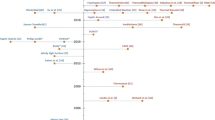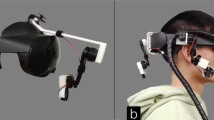Abstract
Recently, several virtual reality (VR) systems that use wind to enhance users’ sensation of presence have been built. In typical systems, wind sources (mostly fans) are arranged rather sparsely around the user. If the fans are arranged more densely, the system can provide a more precise expression of wind direction. However, excessive density is meaningless, because users may not discriminate direction between neighboring fans. In this study, we conducted an experiment to measure the just-noticeable difference (JND) of perception of wind direction, and found a large inter-subject difference. By analyzing the cause of this difference, we find that the locality of wind velocity distribution, together with slight misalignment of the fans, can cause significant errors in wind direction perception.
Access this chapter
Tax calculation will be finalised at checkout
Purchases are for personal use only
Preview
Unable to display preview. Download preview PDF.
Similar content being viewed by others
References
Moon, T., Kim, G.J.: Design and Evaluation of a Wind Display for Virtual Reality. In: ACM Symposium on Virtual Reality Software and Technology, pp. 122–128 (2004)
Kosaka, T., Miyashita, H., Hattori, S.: Development and Evaluation of Immersive 3D Wind Display. IPSJ Symposium Series, vol. 2007(4), pp. 105–112 (2007) (in Japanese)
Cardin, S., Vexo, F., Thalmann, D.: Head Mounted Wind. In: Proceedings of the 20th Annual Conference on Computer Animation and Social Agents, pp. 101–108 (2007)
Heilig, M.L.: Sensorama Simulator. U.S. Patent 3,050,870 (1962)
Deligiannidis, L., Jacob, R.J.K.: The VR Scooter: Wind and Tactile Feedback Improve User Performance. In: Proceedings of the 3D User Interfaces, pp. 143–150 (2006)
Kulkarni, S., Fisher, C., Pardyjak, E., Minor, M., Hollerbach, J.: Wind Display Device for Locomotion Interface in a Virtual Environment. In: World Haptics Conference 2009, pp. 184–189 (2009)
Author information
Authors and Affiliations
Editor information
Editors and Affiliations
Rights and permissions
Copyright information
© 2012 Springer-Verlag Berlin Heidelberg
About this paper
Cite this paper
Nakano, T., Saji, S., Yanagida, Y. (2012). Indicating Wind Direction Using a Fan-Based Wind Display. In: Isokoski, P., Springare, J. (eds) Haptics: Perception, Devices, Mobility, and Communication. EuroHaptics 2012. Lecture Notes in Computer Science, vol 7283. Springer, Berlin, Heidelberg. https://doi.org/10.1007/978-3-642-31404-9_17
Download citation
DOI: https://doi.org/10.1007/978-3-642-31404-9_17
Publisher Name: Springer, Berlin, Heidelberg
Print ISBN: 978-3-642-31403-2
Online ISBN: 978-3-642-31404-9
eBook Packages: Computer ScienceComputer Science (R0)




